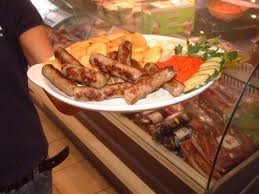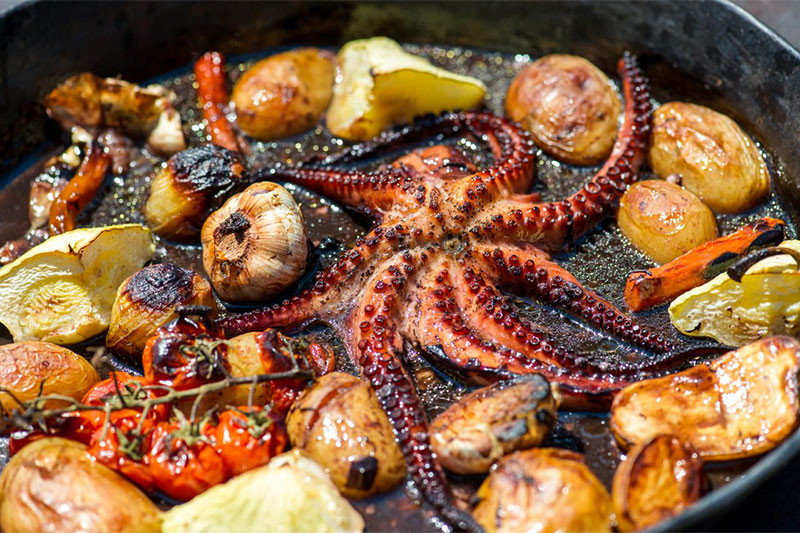Things you should know about Croatian food and drink

Hello boys, girls and people in general. Whoever says that they are not interested in the food of a country they are going to travel are liars and I am very fond of eating, I have become interested in death. So, I am going to share my impressions with your simple souls. Whenever someone thinks about Croatian foods they imagine greasy meat fillets accompanied by potatoes and meat presented in a strange way, well you are very wrong. While it has strong Eastern European roots and satisfies the palatial Balkan carnivores, Croatian food is a delicious mix of flavours that reflect the variety of cultures that have influenced this country throughout history. There is a clear distinction between the Italian cooking style on the coast and tastes of the Hungarian, Austrian and Turkish of the continental zones. From grilled sea bass in olive oil from Dalmatia to a consistent meat stew with paprika (spicy) in Slavonia, every pallet can find something to their taste. Every zone proudly offers their own specialities, although the food is usually surprisingly good and elaborated everywhere, with fresh, seasonal ingredients.
The price and the quality of the food varies a little within the mid-range price category, however, if you are willing to waste it, you can spend hours tasting delicacies which have been slow cooked or tasting modern creations by young people and promising chefs. The Croatians have their limits in terms of prices, so the restaurants are usually grouped around the middle price band, although there are some which are incredibly cheap and others brutally, extortionately expensive. Whatever your budget, it is difficult to eat badly in Croatia. Also, often the eating concept includes a table outside in a warm atmosphere. Although the Croatians don't like to experiment with their food and or diet, it is an area that they are passionate about. They can spend hours discussing the quality of lamb or the best fish, (said conversations have provoked the formation of good friendships), according to those who overshadow the food from other places. The gastronomic culture is increasing, largely thanks to the movement of 'Slow Food', which places emphasis on seasonal, fresh ingredients and the joy of eating for hours. Istria and Kvarner have increased rapidly to the highest gastronomic level, however, there are other places that are not going to lag far behind. A new generation of chefs has emerged, updating the traditional Croatian dishes and who are uniting with the group of chefs who are most celebrated in the world. The production of wine and olive oil has been 'reactivated' and there are actually a multitude of signs on the roads singing the praises of these sweet and delicious nectar's.
Go to Zagreb and northwest of Croatia if you prefer the meat dishes. Juicy roast beef, lamb, svinjetina (pork) or patka (duck), often accompanied by baked noodles or peceni krumpir (roasted potatoes). The meat made slowly under a peka (vaulted roasting cap) is incredibly delicious, but in many restaurants you have to ask for it in advance. The purica (turkey) with mlinci is practically an institution of the Zagreb and Zagorje menus, along with zagrebacki odrezak (fillet that is stuffed with ham and cheese and coated with breadcrumbs), another one that is really loaded with calories. For the sweet-toothed, a typical dessert is palacinke (thin crepes) with several layers and toppings. Slavonia cuisine, more spicy than other regions, uses the important properties of paprika and garlic. Here the Hungarian influence is clearer, since many typical dishes like the cobanac (meat stew), are in fact versions of gulas (goulash). The nearby river provides fresh fish such as carp, pike and bass, which are cooked in stews in a sauce with paprika and served with noodles in a well-known dish. Another speciality is the carp strung on a branch, roasted in its own juice on the grill. The sausages of the region are especially famous, especially the sausage seasoned with paprika, cured for nine months and usually served with cottage cheese, peppers and tomatoes.

The cooking on the coast is typically Mediterranean. Olive oil, garlic, fish, fresh shell fish and herbs are usually used here. By the coast you can find 'lignje' (calamari) lightly coated in breadcrumbs and as the main dish; the calamari from the Adriatic sea is usually more expensive than other places that are further away. Food is often started with a starter of pasta like spaghetti or risotto with seafood. A special starter is a strong cheese from the Island of Pag. The 'brodet dálmata' (varied fish stew served with polenta, also known as brodetto) is another regional delicacy, but often you can only ask for enough for two people. The 'pasticada dalmata' (beef stew with wine and spices served with gnocchi) appears just as much on menus on the coast as further inland. The beef from Cres and Pag, from delicious meat, is considered the best in Croatia, since it is fed on fresh grass.

In recent years, the food from Istria continues to attract international sybarites due to its gastronomic tradition, its fresh products and its unique specialities. Within the typical dishes, I should highlight: the 'manestra', a special soup of vegetables and beans; the 'fuzi', pasta often hand made, served with truffles or 'divljac' (game meat); and the 'fritaja' (tortilla, often served with seasonal vegetables, like green asparagus). The 'prsut' (ham) from Istria and also from Dalmatia, cured and finely cut. The secret can be found through the strong taste of cheese from Pag, the wild herbal diet. The olive oil from Istria, award winning, is considered excellent; the tourism office has marked an olive oil route which allows you to visit local producers and taste the oils they make. The best seasonal ingredients include the white truffle, that can be found during Autumn, and wild asparagus that you can find in Spring.
Eating pizza is also a good option in Croatia. They can be very thin and crunchy to thick and spongy, and their ingredients are used with intelligence and care. To choose something quickly you can have small spicy ox, lamb or chopped pork sausages. Pljeskavica (an ex-ugoslav version of the hamburger), raznjici (small pieces of roasted pork and skewer) or burek (pasta stuffed with meat or cheese).
To finish, in the gastronomic aspect, I would like to tell you about the 'Slow Food'. It was only a matter of time before fast food, with its industrial concept and little respect to the world of food, would gain an enemy. Slow Food has come face to face with the fast food tendency that was taking over the world. This movement, which originates from Italy in 1980, has extended to more than 120 countries; its objective is to conserve the culture of different cuisines with emphasis on vegetables, native animals, bred in a traditional way. Although there are an infinity of interpretations of Slow Food, Croatia has its own version of concept that is centered on promoting the use of local, fresh and seasonal ingredients, Chef Ramsey style. It places a lot of emphasis both on the ritual of the food as well as the presentation. These dishes are served in small portions and they are presented in a certain order. There is a long wait between dishes and they go with the right wines. It is about enjoying the food, understanding where it comes from and what you are eating. When Nenad Kukurin, the owner of the Kukuriku restaurant in Rijeka, introduced the concept nearly a decade ago, they named him 'gastronomic terrorist'. Now, Kukurin is highly respected and he has created a motive that is more sufficient reason to reach the gulf of Kvarner. The bread and everything in general is homemade, the aromatic herbs are handpicked from the restaurants garden and the ingredients are fresh from the market. The owner goes to the market in Rijeka everyday, calls the chef on the phone and together, in that moment, they select the menu for the day according to the things that are currently on offer. If you eat either wild asparagus from Ucka, truffles from the Motovun Forrest or lamb from a nearby village, all the ingredients are pure, without excessive production. In the words of Nena Kukurin: "The objective of good food is that it leaves you feeling light and happy".
In terms of drinks I am a little more lost but I can tell you that one of the most famous drinks is the 'rakija' (liquor) that you can find in many different flavours. The most common that dominate are: loza (grape liqueur), sljivovica (plum liqueur) and travarica (herbal liqueur). In Istria the 'travaricais' is especially good, and is made in several flavors, from medica (honey) to lesea (mistletoe) and diverse berries. The island of Vis is famous for its delicious carob liqueur. It is customary to drink a glass of liquor before eating. Other popular drinks are vinjak (cognac) or the Italian ancestry prosecco (sweet wine for desserts). The best types of Croatian pivo (beer) are the Oiujsko of laceb and the Karlovacko of Karlovac. Velebitsko beer has loyal followers among connoisseurs but it is only distributed in a few places, mostly in mainland Croatia. In terms of wines, technically each region produces its own wine, although the best ones are those of Istria, mainly made in local varieties. The tourist office has proposed wine routes all over the peninsula, so you can lose yourself among the winegrowers and in their cellars. Dalmatia has a great wine tradition and also Slavonia.
Expresso-style coffee served in small cups is very popular in Dalmatia. It can be drunk with a little milk. Although in some places decaf is offered, the Croatians drink it with caffeine but consider it a small sacrilege. If you do not like anything that I have mentioned, tap water can be drunk, no problem.
Photo gallery
Content available in other languages
Want to have your own Erasmus blog?
If you are experiencing living abroad, you're an avid traveller or want to promote the city where you live... create your own blog and share your adventures!
I want to create my Erasmus blog! →







Comments (0 comments)